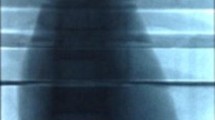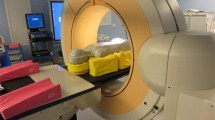Abstract
Introduction
Minimally invasive fluoroscopy-guided screw fixation is an established technique to stabilize fractures of the posterior pelvic ring in orthopaedic surgery. However, safe placement of the screws may be associated with prolonged intervention time and extensive fluoroscopy is a concern. In the current literature, the dose area product (DAP) and fluoroscopy time are often used to describe radiation exposure of the patient. It was the aim of the study to compare DAP to organ doses and the effective dose for four standard views commonly used in pelvic surgery.
Methods
An anthropomorphic cross-sectional dosimetry phantom, representing the body of a male human (173 cm/73 kg), was equipped with metal–oxide–semiconductor field-effect transistors (MOSFET) in different organ locations to measure radiation exposure. Anteroposterior (APV), lateral (LV), outlet (OLV) and inlet (ILV) of the phantom were obtained with a mobile C-arm, and effective dose and organ doses were calculated. DAP was measured in the built-in ionisation chamber beyond the collimator of the C-arm. The measurements were repeated with a fat layer to simulate an obese patient.
Results
Overall, the highest organ dose was measured in the stomach for ILV (0.918 mSv/min). Effective dose for ILV showed the highest values by far (1.85 mSv/min) and the lowest for LV (0.46 mSv/min). The DAP pattern was completely different to the effective dose with similar values for LV and ILV (12.2 and 12.3 µGy·m2/s). Adding a fat layer had no major effect on the measurements.
Conclusion
The exposure to radiation varies considerably between different orthopaedic standard views of the pelvis. About the fourfold amount of the effective dose was measured for ILV compared to LV. DAP and irradiation time do not respect either the body region in the field of radiation or the radiosensitivity of the affected organs. Thus, they do not allow a reliable interpretation of the radiation burden the patient is exposed to.








Similar content being viewed by others
References
Routt ML, Kregor PJ, Simonian PT, Mayo KA (1995) Early results of percutaneous iliosacral screws placed with the patient in the supine position. J Orthop Trauma. [Internet] 9(3):207–14
Gardner MJ, Routt MLC (2011) Transiliac-transsacral screws for posterior pelvic stabilization. J Orthop Trauma [Internet]. 25(6):378–84
Matta JM, Saucedo T (1989) Internal fixation of pelvic ring fractures. Clin Orthop Relat Res [Internet]. 1(242):83–97
Chip Routt ML, Meier MC, Kregor PJ, Mayo KA (1993) Percutaneous iliosacral screws with the patient supine technique. Oper Tech Orthop [Internet]. 3(1):35–45
Miller AN, Routt MLC (2012) Variations in Sacral Morphology and Implications for Iliosacral Screw Fixation. Am Acad Orthop Surg [Internet]. 20(1):8–16
Hilgert RE, Finn J, Egbers HJ (2005) Technik der perkutanen SI-verschraubung mit unterstützung durch konventionellen C-bogen. Unfallchirurg 108:954–960
Zwingmann J, Konrad G, Kotter E, Südkamp NP, Oberst M (2009) Computer-navigated iliosacral screw insertion reduces malposition rate and radiation exposure. Clin Orthop Relat Res [Internet]. 467(7):1833–8
Dosimetry in Diagnostic Radiology: An International Code of Practice [Internet]. Vienna: International Atomic Energy Agency; 2007. Available from: https://www.iaea.org/publications/7638/dosimetry-in-diagnostic-radiology-an-international-code-of-practice
The 2007 Recommendations of the International Commission on Radiological Protection. ICRP publication 103. Ann ICRP [Internet]. 2007;37:1–332. Available from: http://www.ncbi.nlm.nih.gov/pubmed/18082557
Aalbers T, Duane S, Kapsch R-P, Meghzifene A. (2008) Measurement uncertainty - a practical guide for secondary standards dosimetry laboratories [Internet]. Available from: https://www-pub.iaea.org/MTCD/publications/PDF/te_1585_web.pdf
Routt ML, Simonian PT, Mills WJ (1997) Iliosacral screw fixation: early complications of the percutaneous technique. J Orthop Trauma [Internet]. 11(8):584–9
Briem D, Windolf J, Rueger JM (2007) Percutaneous, 2D-fluoroscopic navigated iliosacral screw placement in the supine position: technique, possibilities, and limits. Unfallchirurg [Internet]. 110(5):393–401
Zwingmann J, Konrad G, Kotter E, Südkamp NP, Oberst M (2009) Computer-navigated iliosacral screw insertion reduces malposition rate and radiation exposure. Clin Orthop Relat Res. 467(7):1833–8
Richter PH, Steinbrener J, Schicho A, Gebhard F (2016) Does the choice of mobile C-arms lead to a reduction of the intraoperative radiation dose? Injury [Internet]. 47(8):1608–12
Acknowledgements
We thank Siemens Healthineers GmbH in Forchheim, Germany for supporting this study. A special thanks goes to Elizaveta Stepina, Hauke Prenzel, Robert Brauweiler and Peter Bartl for their technical support.
Author information
Authors and Affiliations
Contributions
Conceptualization, H.K., E.B. and C.M.; Methodology, H.K., E.B., V.F. and C.M.; Investigations, H.K., E.B., C.M.; Writing – Original Draft, H.K. and C.M; Writing – Review & Editing, E.B. and V.F.; Visualization, H.K. and C.M; Supervision, E.B. and C.M.; Projekt Administration, C.M.
Corresponding author
Ethics declarations
Conflict of interests
The authors declare that they have no conflict of interest. Each author certifies that he or she has no commercial associations (e.g. consultancies, stock ownership, equity interest, patent/licensing arrangements, etc.) that might pose a conflict of interest in connection with the submitted article.
Additional information
Publisher's Note
Springer Nature remains neutral with regard to jurisdictional claims in published maps and institutional affiliations.
Rights and permissions
About this article
Cite this article
Kuttner, H., Benninger, E., Fretz, V. et al. The impact of the fluoroscopic view on radiation exposure in pelvic surgery: organ involvement, effective dose and the misleading concept of only measuring fluoroscopy time or the dose area product. Eur J Orthop Surg Traumatol 32, 1399–1405 (2022). https://doi.org/10.1007/s00590-021-03111-z
Received:
Accepted:
Published:
Issue Date:
DOI: https://doi.org/10.1007/s00590-021-03111-z




